Ying Jin
X-Reasoner: Towards Generalizable Reasoning Across Modalities and Domains
May 06, 2025Abstract:Recent proprietary models (e.g., o3) have begun to demonstrate strong multimodal reasoning capabilities. Yet, most existing open-source research concentrates on training text-only reasoning models, with evaluations limited to mainly mathematical and general-domain tasks. Therefore, it remains unclear how to effectively extend reasoning capabilities beyond text input and general domains. This paper explores a fundamental research question: Is reasoning generalizable across modalities and domains? Our findings support an affirmative answer: General-domain text-based post-training can enable such strong generalizable reasoning. Leveraging this finding, we introduce X-Reasoner, a vision-language model post-trained solely on general-domain text for generalizable reasoning, using a two-stage approach: an initial supervised fine-tuning phase with distilled long chain-of-thoughts, followed by reinforcement learning with verifiable rewards. Experiments show that X-Reasoner successfully transfers reasoning capabilities to both multimodal and out-of-domain settings, outperforming existing state-of-the-art models trained with in-domain and multimodal data across various general and medical benchmarks (Figure 1). Additionally, we find that X-Reasoner's performance in specialized domains can be further enhanced through continued training on domain-specific text-only data. Building upon this, we introduce X-Reasoner-Med, a medical-specialized variant that achieves new state of the art on numerous text-only and multimodal medical benchmarks.
UniCombine: Unified Multi-Conditional Combination with Diffusion Transformer
Mar 12, 2025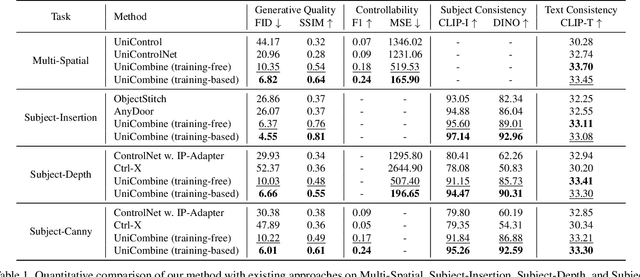
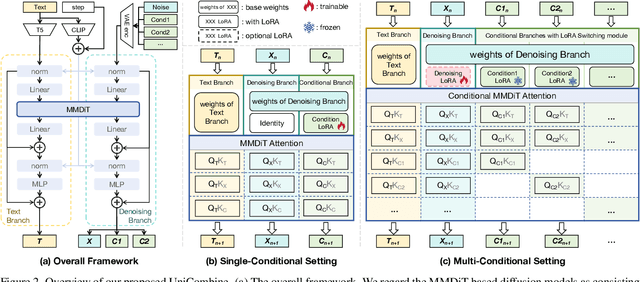


Abstract:With the rapid development of diffusion models in image generation, the demand for more powerful and flexible controllable frameworks is increasing. Although existing methods can guide generation beyond text prompts, the challenge of effectively combining multiple conditional inputs while maintaining consistency with all of them remains unsolved. To address this, we introduce UniCombine, a DiT-based multi-conditional controllable generative framework capable of handling any combination of conditions, including but not limited to text prompts, spatial maps, and subject images. Specifically, we introduce a novel Conditional MMDiT Attention mechanism and incorporate a trainable LoRA module to build both the training-free and training-based versions. Additionally, we propose a new pipeline to construct SubjectSpatial200K, the first dataset designed for multi-conditional generative tasks covering both the subject-driven and spatially-aligned conditions. Extensive experimental results on multi-conditional generation demonstrate the outstanding universality and powerful capability of our approach with state-of-the-art performance.
Beyond Reweighting: On the Predictive Role of Covariate Shift in Effect Generalization
Dec 12, 2024Abstract:Many existing approaches to generalizing statistical inference amidst distribution shift operate under the covariate shift assumption, which posits that the conditional distribution of unobserved variables given observable ones is invariant across populations. However, recent empirical investigations have demonstrated that adjusting for shift in observed variables (covariate shift) is often insufficient for generalization. In other words, covariate shift does not typically ``explain away'' the distribution shift between settings. As such, addressing the unknown yet non-negligible shift in the unobserved variables given observed ones (conditional shift) is crucial for generalizable inference. In this paper, we present a series of empirical evidence from two large-scale multi-site replication studies to support a new role of covariate shift in ``predicting'' the strength of the unknown conditional shift. Analyzing 680 studies across 65 sites, we find that even though the conditional shift is non-negligible, its strength can often be bounded by that of the observable covariate shift. However, this pattern only emerges when the two sources of shifts are quantified by our proposed standardized, ``pivotal'' measures. We then interpret this phenomenon by connecting it to similar patterns that can be theoretically derived from a random distribution shift model. Finally, we demonstrate that exploiting the predictive role of covariate shift leads to reliable and efficient uncertainty quantification for target estimates in generalization tasks with partially observed data. Overall, our empirical and theoretical analyses suggest a new way to approach the problem of distributional shift, generalizability, and external validity.
DAug: Diffusion-based Channel Augmentation for Radiology Image Retrieval and Classification
Dec 06, 2024



Abstract:Medical image understanding requires meticulous examination of fine visual details, with particular regions requiring additional attention. While radiologists build such expertise over years of experience, it is challenging for AI models to learn where to look with limited amounts of training data. This limitation results in unsatisfying robustness in medical image understanding. To address this issue, we propose Diffusion-based Feature Augmentation (DAug), a portable method that improves a perception model's performance with a generative model's output. Specifically, we extend a radiology image to multiple channels, with the additional channels being the heatmaps of regions where diseases tend to develop. A diffusion-based image-to-image translation model was used to generate such heatmaps conditioned on selected disease classes. Our method is motivated by the fact that generative models learn the distribution of normal and abnormal images, and such knowledge is complementary to image understanding tasks. In addition, we propose the Image-Text-Class Hybrid Contrastive learning to utilize both text and class labels. With two novel approaches combined, our method surpasses baseline models without changing the model architecture, and achieves state-of-the-art performance on both medical image retrieval and classification tasks.
LDA-AQU: Adaptive Query-guided Upsampling via Local Deformable Attention
Nov 29, 2024



Abstract:Feature upsampling is an essential operation in constructing deep convolutional neural networks. However, existing upsamplers either lack specific feature guidance or necessitate the utilization of high-resolution feature maps, resulting in a loss of performance and flexibility. In this paper, we find that the local self-attention naturally has the feature guidance capability, and its computational paradigm aligns closely with the essence of feature upsampling (\ie feature reassembly of neighboring points). Therefore, we introduce local self-attention into the upsampling task and demonstrate that the majority of existing upsamplers can be regarded as special cases of upsamplers based on local self-attention. Considering the potential semantic gap between upsampled points and their neighboring points, we further introduce the deformation mechanism into the upsampler based on local self-attention, thereby proposing LDA-AQU. As a novel dynamic kernel-based upsampler, LDA-AQU utilizes the feature of queries to guide the model in adaptively adjusting the position and aggregation weight of neighboring points, thereby meeting the upsampling requirements across various complex scenarios. In addition, LDA-AQU is lightweight and can be easily integrated into various model architectures. We evaluate the effectiveness of LDA-AQU across four dense prediction tasks: object detection, instance segmentation, panoptic segmentation, and semantic segmentation. LDA-AQU consistently outperforms previous state-of-the-art upsamplers, achieving performance enhancements of 1.7 AP, 1.5 AP, 2.0 PQ, and 2.5 mIoU compared to the baseline models in the aforementioned four tasks, respectively. Code is available at \url{https://github.com/duzw9311/LDA-AQU}.
Optimized Conformal Selection: Powerful Selective Inference After Conformity Score Optimization
Nov 27, 2024



Abstract:Model selection/optimization in conformal inference is challenging, since it may break the exchangeability between labeled and unlabeled data. We study this problem in the context of conformal selection, which uses conformal p-values to select ``interesting'' instances with large unobserved labels from a pool of unlabeled data, while controlling the FDR in finite sample. For validity, existing solutions require the model choice to be independent of the data used to construct the p-values and calibrate the selection set. However, when presented with many model choices and limited labeled data, it is desirable to (i) select the best model in a data-driven manner, and (ii) mitigate power loss due to sample splitting. This paper presents OptCS, a general framework that allows valid statistical testing (selection) after flexible data-driven model optimization. We introduce general conditions under which OptCS constructs valid conformal p-values despite substantial data reuse and handles complex p-value dependencies to maintain finite-sample FDR control via a novel multiple testing procedure. We instantiate this general recipe to propose three FDR-controlling procedures, each optimizing the models differently: (i) selecting the most powerful one among multiple pre-trained candidate models, (ii) using all data for model fitting without sample splitting, and (iii) combining full-sample model fitting and selection. We demonstrate the efficacy of our methods via simulation studies and real applications in drug discovery and alignment of large language models in radiology report generation.
MedImageInsight: An Open-Source Embedding Model for General Domain Medical Imaging
Oct 09, 2024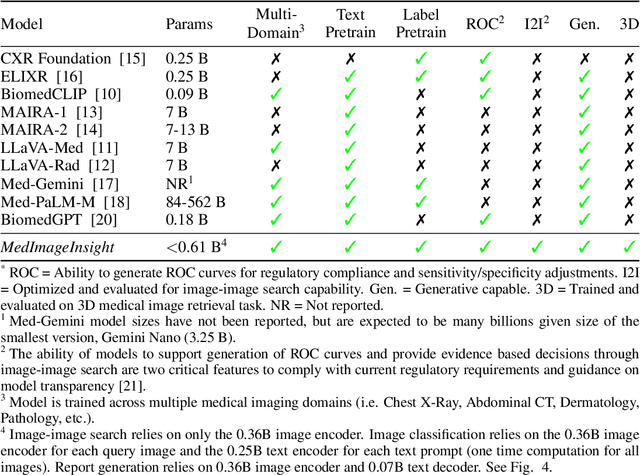
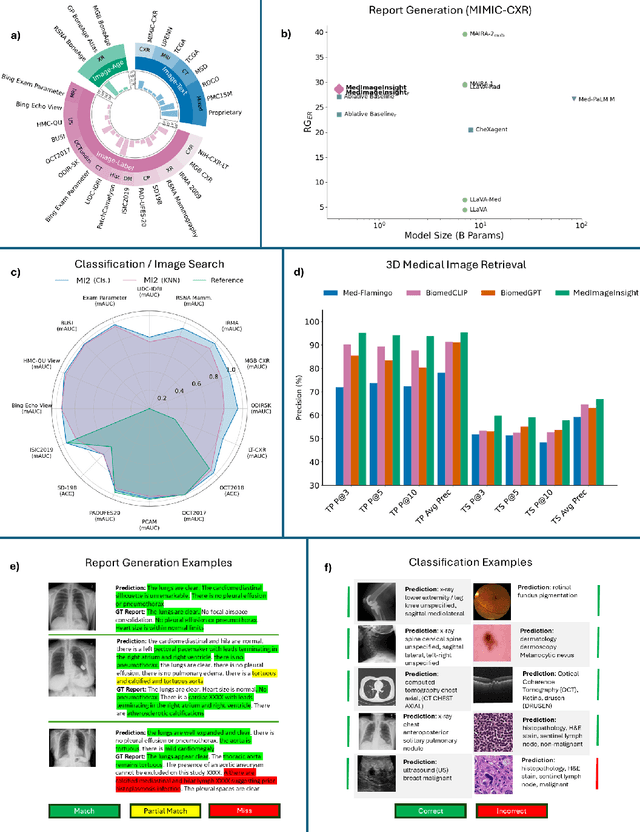
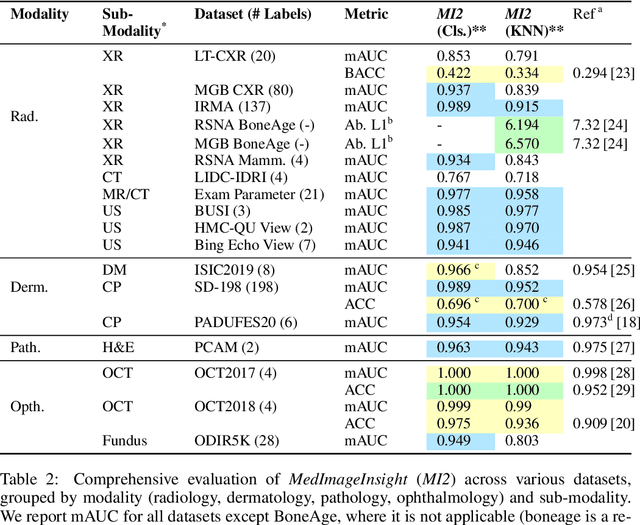
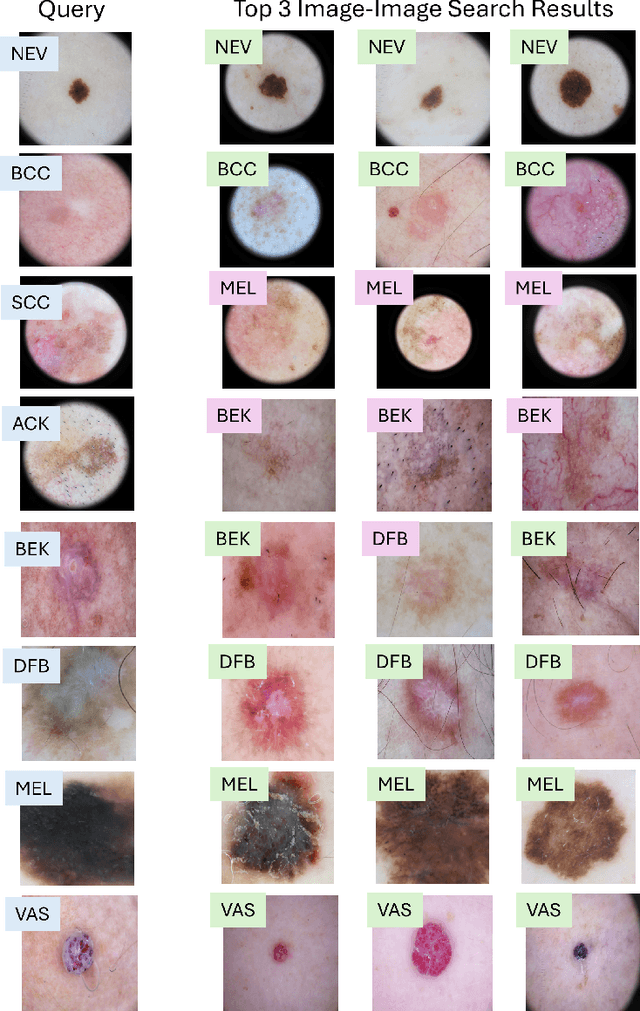
Abstract:In this work, we present MedImageInsight, an open-source medical imaging embedding model. MedImageInsight is trained on medical images with associated text and labels across a diverse collection of domains, including X-Ray, CT, MRI, dermoscopy, OCT, fundus photography, ultrasound, histopathology, and mammography. Rigorous evaluations demonstrate MedImageInsight's ability to achieve state-of-the-art (SOTA) or human expert level performance across classification, image-image search, and fine-tuning tasks. Specifically, on public datasets, MedImageInsight achieves SOTA in CT 3D medical image retrieval, as well as SOTA in disease classification and search for chest X-ray, dermatology, and OCT imaging. Furthermore, MedImageInsight achieves human expert performance in bone age estimation (on both public and partner data), as well as AUC above 0.9 in most other domains. When paired with a text decoder, MedImageInsight achieves near SOTA level single image report findings generation with less than 10\% the parameters of other models. Compared to fine-tuning GPT-4o with only MIMIC-CXR data for the same task, MedImageInsight outperforms in clinical metrics, but underperforms on lexical metrics where GPT-4o sets a new SOTA. Importantly for regulatory purposes, MedImageInsight can generate ROC curves, adjust sensitivity and specificity based on clinical need, and provide evidence-based decision support through image-image search (which can also enable retrieval augmented generation). In an independent clinical evaluation of image-image search in chest X-ray, MedImageInsight outperformed every other publicly available foundation model evaluated by large margins (over 6 points AUC), and significantly outperformed other models in terms of AI fairness (across age and gender). We hope releasing MedImageInsight will help enhance collective progress in medical imaging AI research and development.
Ascend HiFloat8 Format for Deep Learning
Sep 26, 2024



Abstract:This preliminary white paper proposes a novel 8-bit floating-point data format HiFloat8 (abbreviated as HiF8) for deep learning. HiF8 features tapered precision. For normal value encoding, it provides 7 exponent values with 3-bit mantissa, 8 exponent values with 2-bit mantissa, and 16 exponent values with 1-bit mantissa. For denormal value encoding, it extends the dynamic range by 7 extra powers of 2, from 31 to 38 binades (notice that FP16 covers 40 binades). Meanwhile, HiF8 encodes all the special values except that positive zero and negative zero are represented by only one bit-pattern. Thanks to the better balance between precision and dynamic range, HiF8 can be simultaneously used in both forward and backward passes of AI training. In this paper, we will describe the definition and rounding methods of HiF8, as well as the tentative training and inference solutions. To demonstrate the efficacy of HiF8, massive simulation results on various neural networks, including traditional neural networks and large language models (LLMs), will also be presented.
VI3DRM:Towards meticulous 3D Reconstruction from Sparse Views via Photo-Realistic Novel View Synthesis
Sep 12, 2024



Abstract:Recently, methods like Zero-1-2-3 have focused on single-view based 3D reconstruction and have achieved remarkable success. However, their predictions for unseen areas heavily rely on the inductive bias of large-scale pretrained diffusion models. Although subsequent work, such as DreamComposer, attempts to make predictions more controllable by incorporating additional views, the results remain unrealistic due to feature entanglement in the vanilla latent space, including factors such as lighting, material, and structure. To address these issues, we introduce the Visual Isotropy 3D Reconstruction Model (VI3DRM), a diffusion-based sparse views 3D reconstruction model that operates within an ID consistent and perspective-disentangled 3D latent space. By facilitating the disentanglement of semantic information, color, material properties and lighting, VI3DRM is capable of generating highly realistic images that are indistinguishable from real photographs. By leveraging both real and synthesized images, our approach enables the accurate construction of pointmaps, ultimately producing finely textured meshes or point clouds. On the NVS task, tested on the GSO dataset, VI3DRM significantly outperforms state-of-the-art method DreamComposer, achieving a PSNR of 38.61, an SSIM of 0.929, and an LPIPS of 0.027. Code will be made available upon publication.
DualAnoDiff: Dual-Interrelated Diffusion Model for Few-Shot Anomaly Image Generation
Aug 24, 2024



Abstract:The performance of anomaly inspection in industrial manufacturing is constrained by the scarcity of anomaly data. To overcome this challenge, researchers have started employing anomaly generation approaches to augment the anomaly dataset. However, existing anomaly generation methods suffer from limited diversity in the generated anomalies and struggle to achieve a seamless blending of this anomaly with the original image. In this paper, we overcome these challenges from a new perspective, simultaneously generating a pair of the overall image and the corresponding anomaly part. We propose DualAnoDiff, a novel diffusion-based few-shot anomaly image generation model, which can generate diverse and realistic anomaly images by using a dual-interrelated diffusion model, where one of them is employed to generate the whole image while the other one generates the anomaly part. Moreover, we extract background and shape information to mitigate the distortion and blurriness phenomenon in few-shot image generation. Extensive experiments demonstrate the superiority of our proposed model over state-of-the-art methods in terms of both realism and diversity. Overall, our approach significantly improves the performance of downstream anomaly detection tasks, including anomaly detection, anomaly localization, and anomaly classification tasks.
 Add to Chrome
Add to Chrome Add to Firefox
Add to Firefox Add to Edge
Add to Edge